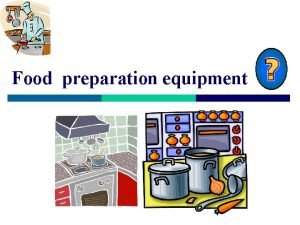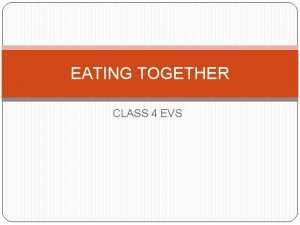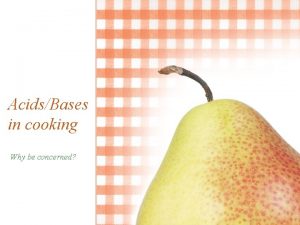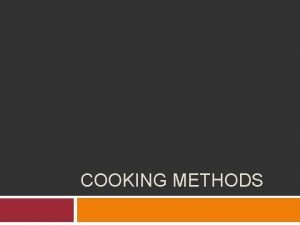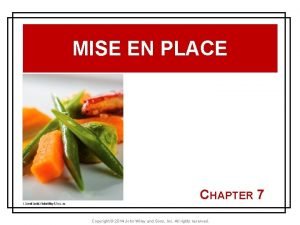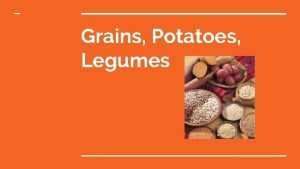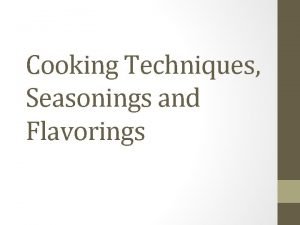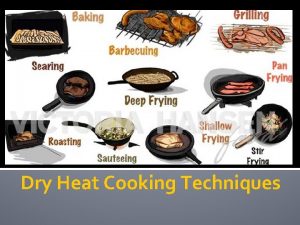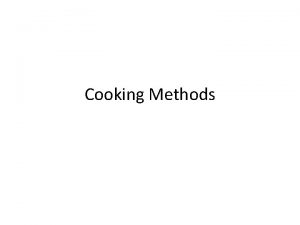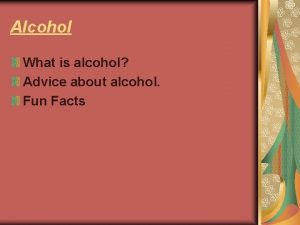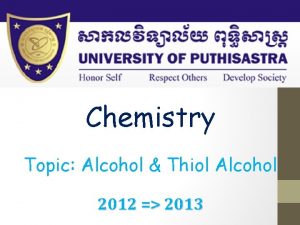Alcohol Stoves and Integrated Cooking Paul S Anderson

















- Slides: 17

Alcohol Stoves and Integrated Cooking Paul S. Anderson, Ph. D psanders@ilstu. edu (A presentation at the PCIA 2007 Conference, 20 – 24 March 2007, Bangalore, India)

Integrated Cooking • Definition: When two or more different modes of cooking are used to complete one cooking task. • Modes of cooking include: – Flames for heat • (alcohol, LPG, kerosene, gases, biomass) – Solar energy for heat – Retained heat cooking (RHC) (“Haybox”) – Electricity for heat (uncommon because of high costs)

Notes on Integrated Cooking • Two or three modes must be present, therefore higher initial costs. • Savings must come in fuel or time. • Transition between modes is crucial and needs to be simple/easy/safe. • Best if minimum movement of the pot. • User awareness of integrated cooking is extremely low.

Mode 1: Flames for Heat • Flame control is a great advantage in integrated cooking. • Sometimes short-time, fast heat is needed. • Ability to ignite, extinguish, re-ignite, and control flame height gives control to user. • Therefore, the advantage goes to liquids and gaseous fuels, not to solid biomass fuels. • Alcohol is the only renewable liquid fuel of quality for cookstoves.

Alcohol as a Fuel • • Alcohol has virtually no bad emissions. No chimney or ventilation needed. Renewable and liquid. Ethanol or Methanol or mixed. Denatured (not for drinking); safe handling. A favorite fuel of backpackers. Fuel production costs per unit of energy are already competitive with processed fossil fuels like LPG and kerosene. • Widely available, but nationally controlled.

Types of Alcohol Stoves • Pressurized: Pump adds cost and maintenance; often includes stove structure/pot support. • Non-pressurized: – Dometic-style: Incl. stove structure – Fondue-style: No stove structure • Self-pressurized: Mainly very small, lightweight backpacker units with minimal stove structure. – Trangia: Brass – “Beverage-can” stove: Aluminum – The “Lily burner”: Steel (as in tin cans)

The “Lily Burner” The white Lily flower is a symbol of purity and is an appropriate name for a clean-burning alcohol stove. • A steel “tin-can” variation of the aluminum “beverage-can” alcohol burner. • Created in 2006. • Many variations in can sizes & number of flame holes.

Principles of Non-Pressurized Alcohol Burners • The burning flame causes the fuel canister to be warm for sufficient vaporization of the liquid alcohol. • The “top-to-bottom conduction” of heat is facilitated by aluminum, brass, and metalto-metal contact of stove parts. • The steel “tin-cans” of the Lily burner are poor conductors of heat, so vertical aluminum posts are added inside the cans.

Construction of a Lily Burner • Use two 3 -inch (7. 5 cm) food cans. • Fiberglass insulation keeps liquid from spilling out. • Bolt in top is for refilling. • Flame holes: variable number and size.

Stove Structures • Many designs of stove structures are compatible with the Lily burner. Prestige versions for affluent people are possible. • Mud or bricks plus steel rebar create a stove. • One burner under one pot is usually sufficient heat.

With tongs or holders, the user slides the needed number of burners under the application (shown is a griddle). The lower gap is important for ignition and intensity control using an ignition device.

Control of the Alcohol • Refilling is via pouring, pumping, or syringe for ejection. • The ignition device can be made from a spoon and ceramic fiber. • All construction is low cost, low tech, and long -lasting.

Mode 2: Solar Energy for Heat • The Hot. Pot (by SHE) is complete for solar cooking with reflector, glass bottom, inner black pot, & glass lid. • Or place the black pot and lid into a stove structure for an alcohol burner for morning, evening, or cloudy-day cooking.

Mode 3: Retained Heat Cooking • Remove or extinguish the alcohol burner, then wrap the entire stove structure and the Hot. Pot with insolating blankets. • Additional heat can be added (with care) at any time.

Alcohol as a “Thermal Booster” • Alcohol burners can be inserted into or under (with inlet hole) solar box-cookers. Allow adequate air during combustion, but otherwise the box can be kept closed. • Alcohol burners will self-extinguish when the fuel ends, so the fuel-load will determine the amount of extra heat. • The potential for alcohol stoves and integrated cooking is immense, with ZERO harmful emissions!!! • Participation by others is most welcome!!!

References • Find out more about “beverage can stoves” at: – http: //wikipedia. org/wiki/Beverage_can_stove – http: //zenstoves. net

Brite. Lyt lanterns run on a variety of fuels. . . kerosene, alcohol-based fuels, mineral spirits, citronella oil, gasoline, Biodiesel, diesel fuel, Coleman fuel, & almost every flammable fuel available on the market, including Methanol, Ethanol and all Alcohol Fuels. Visit Brite. Lyt Online at: www. britelyt. com
 Lorena stove
Lorena stove Lopi wood stoves
Lopi wood stoves Formation of alcohols
Formation of alcohols Primary and secondary alcohol oxidation
Primary and secondary alcohol oxidation Anderson and mcfarlane community assessment wheel
Anderson and mcfarlane community assessment wheel The anderson school gifted and talented nyc
The anderson school gifted and talented nyc Bartholow and anderson 2002
Bartholow and anderson 2002 Cooking makes food soft tasty and
Cooking makes food soft tasty and Difference between primary and auxiliary cooking equipment
Difference between primary and auxiliary cooking equipment The cooking and eating together in a gurudwara is called
The cooking and eating together in a gurudwara is called Acids and bases in cooking
Acids and bases in cooking Know your equipment
Know your equipment Is microwaving a dry heat method
Is microwaving a dry heat method Preliminary cooking and flavoring
Preliminary cooking and flavoring Cooking pasta and rice activity 2 chapter 30
Cooking pasta and rice activity 2 chapter 30 Hillingdon arch
Hillingdon arch Alcohol is the most commonly used drug in our society
Alcohol is the most commonly used drug in our society Chapter 8 toxicology poisons and alcohol
Chapter 8 toxicology poisons and alcohol








